OPPO Reno3 Review; Photo Expert and Beyond
OPPO Reno3 and
Around December last 2019, OPPO launched the third generation Reno devices in their home country, then quickly followed by India. Earlier last March, OPPO Philippines was set to launch theand Reno3 Pro locally. However, due to Enhanced Community Quarantine caused by the global COVID-19 pandemic, it was pushed back to April. Now we have both units to test out, and for this review, we will first tackle the non-pro variant.

OPPO Reno3 Review; Photo Expert and Beyond
OPPO Reno3 came quickly after its predecessor, the Reno2, that was released locally in October of 2019, which is barely six months. So, what changed from that short period? Let’s all find out in this review.
PHYSICAL:
Unlike the

Front
The 6.4-inch AMOLED panel mainly occupies the facade of the phone with a 90.8% screen-to-body ratio. It has Full HD+ resolution, that’s 2,400 x 1,080 pixels. There is no information about what kind of protective glass it has, but our review unit came with a pre-installed plastic film. So, that at least gives us peace of mind that it is protected against daily wear and tear.
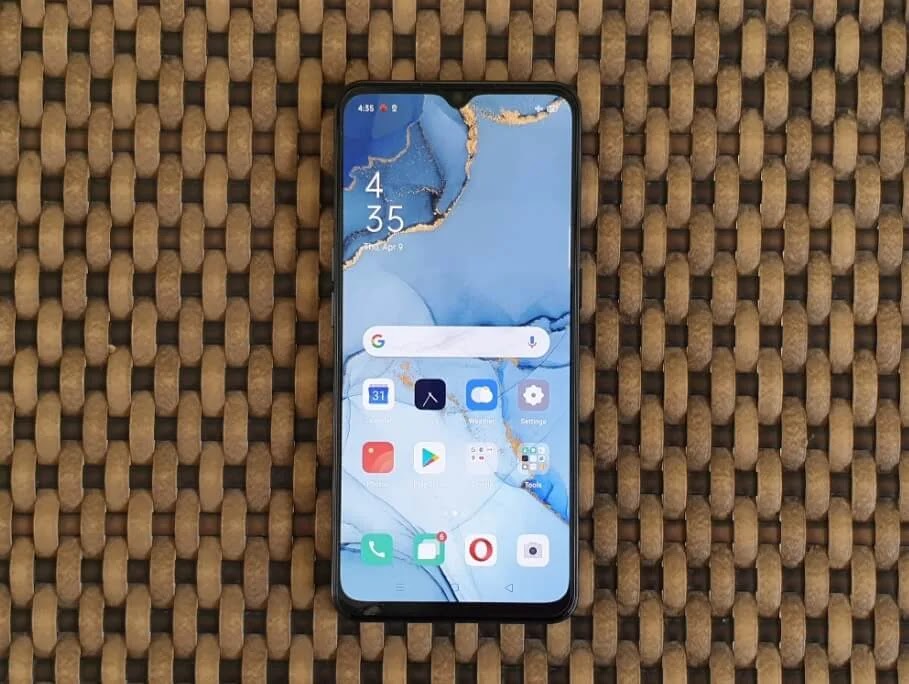
6.4-inch AMOLED Display
As expected, the AMOLED screen offers a bright display with good viewing angles and deep contrast. Meanwhile, the display settings have extensive items for users to tweak, such as the Low-Brightness Flicker-Free Eye Care to reduces visual fatigue, and Screen Color Temperature adjustment. Another thing is the system-wide Dark Mode, which is suitable for phones with AMOLED display.
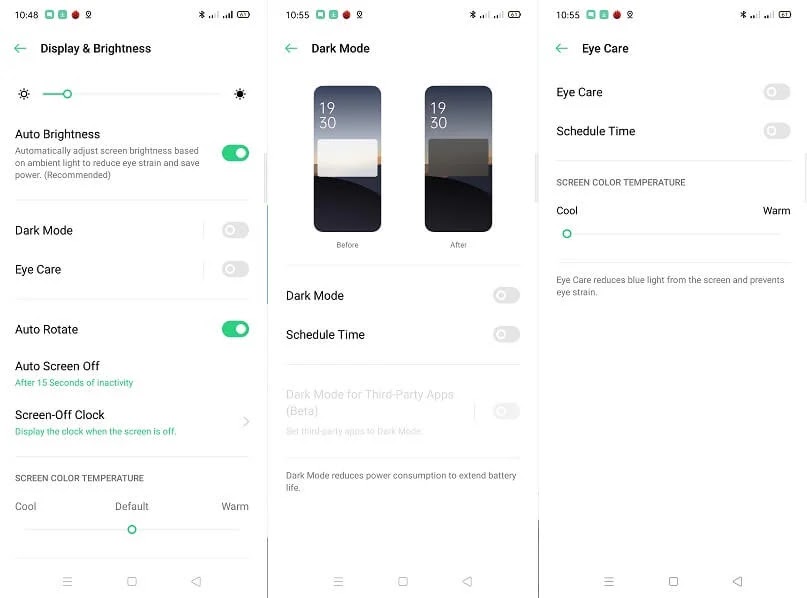
Display Settings
The Reno3 is thinner and lighter, it only measures 160.2mm x 73.3mm x 7.9mm and weighs only 170 grams, when compared to both the Reno2’s 160mm x 74.3mm x 9.5mm and 189 grams, and Reno2 F’s 161.8mm x 75.8mm x 8.7mm and 195 grams. Yes, we agree it is sleeker, however, on its back is the noticeable camera bump, something that you won’t find in the last year’s Reno family.

Back, Midnight Black
Going at the back, it has OPPO’s “light-lapse” design with glass or glass-like finish. It comes in 3 color options, that one we have for review is called the Midnight Black, and the other two are Sky White and Aurora Blue.
Moving through the sides, the top has the primary microphone, while the bottom holds the 3.5mm audio port, secondary microphone pinhole, USB Type-C port, and the loudspeaker grille. The right side has the power button, while the left has the volume keys and the triple card tray.
By the way, the power button also doubles as the button for Google Assistant by default, but you can disable it under the system settings. When it is enabled, pressing and holding the button will first wake-up the digital assistant, while holding it for 3 seconds will prompt the power-off screen menu.
You might notice in the above images that it has no visible fingerprint sensor, that is because it is placed underneath the display. It is an optical sensor, and it works quite fast. OPPO says that unlocking speed is 0.34s, and we can say it is true. Once you touched the display, it unlocks instantly, and the fireworks-like animation when unlocking looks cool too!
OPPO just lent as only the unit itself, but according to their website, the retail package comes with free case, 30W VOOC charger, USB cable, earphones, SIM ejector tool, and paper documents.
See Also:
SOFTWARE:
It runs on the latest OPPO software called
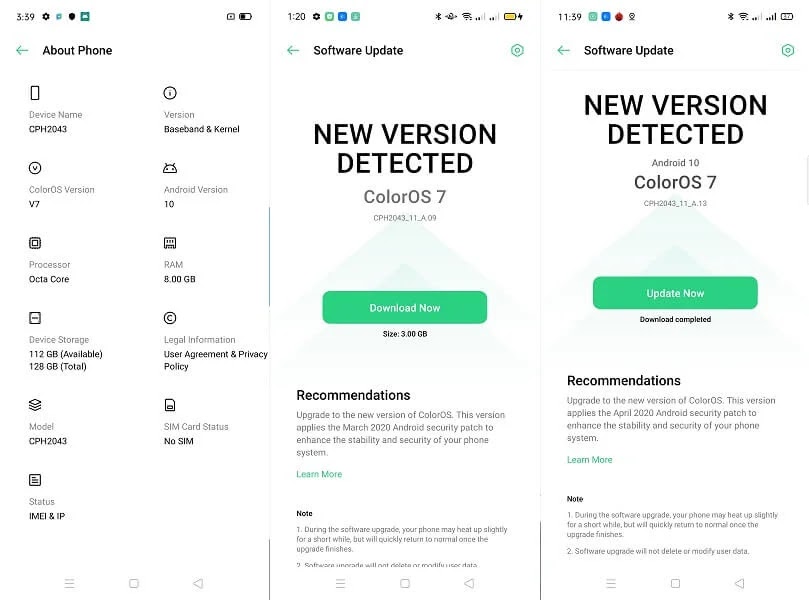
Software
By the way, it has 128GB of internal storage, wherein 16.2GB is used upon the first boot up – 15.7GB for the system and 469MB for the pre-installed apps.
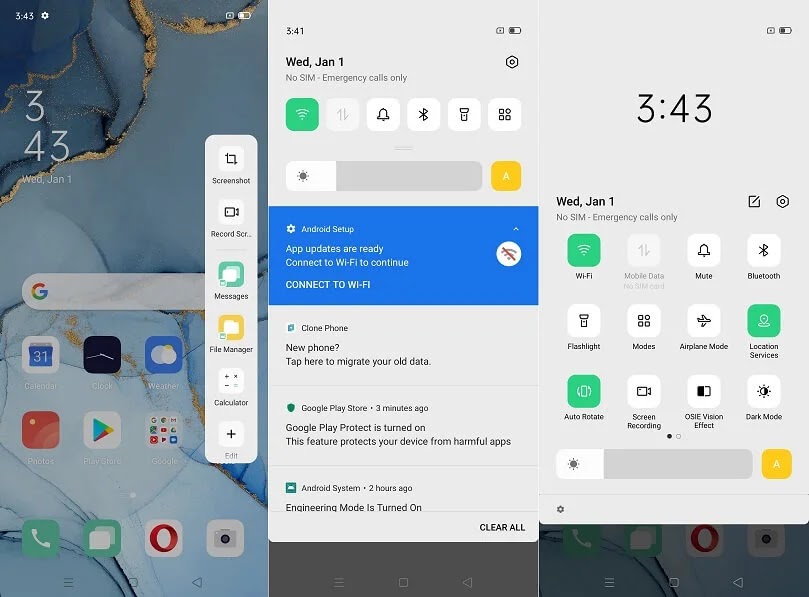
User Interface
Moving on, the new custom Android-based operating system of OPPO has the tagline Smooth and Delightful. It has upgraded aesthetic features, such as livelier style and more comfortable visual effects.
It is also equipped with AI that accurately identifies usage scenarios through big data analysis. OPPO calls them oFas, a mechanism of cache preload that makes cold starts as fast as warm starts; oMem that adapts to user habits by shifting and allocating system resources accordingly and efficiently; and oSense, a scheduling mechanism that gives priority to front-end and user-related threads.
Moreover, it comes with lots of cool items; some of them are as follows:
- Soloop – a pre-installed app, which is a smart short video editor that lets users instantly create and share videos.
- Music Party – another pre-installed application that allows several phones to play the same song together.
- Text Scanner – sharpen the texts on your photos to get clearer document images.
- Wireless Printing – it comes with a built-in print service wherein users can print directly to printers that support Mopria Print Service.
- Multi-User Mode – as the name implies, it allows you to create different users for better privacy. Each user has their own space and cannot view or change the other user’s app data.
- Game Space – an algorithm that is dedicated for smoother and lag-free gaming.
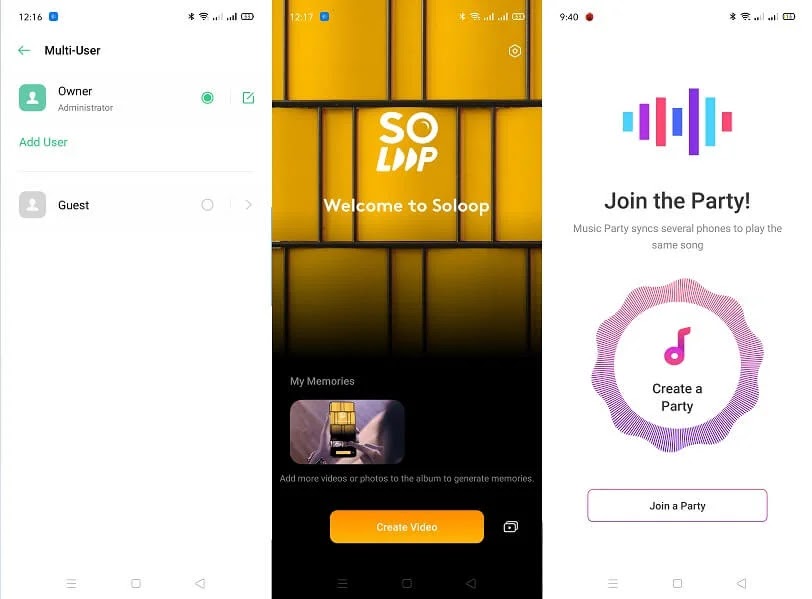
Multi-User, Soloop, Music Party
Of course, popular features of the previous ColorOS version are still there, such as the Clone Phone, Smart Sidebar, Smart Assistant, and App Lock. Users can also easily access Screen Recording, OPPO Share, and Dark Mode through the quick settings menu.

Dark Mode
To learn more about ColorOS, you can visit
PERFORMANCE:
The Reno3 is the first device that we reviewed that is powered by
As always, we run it through our favorite benchmarking tools, and the scores are as follows.
Benchmark
OPPO A9 2020
Realme C3
OPPO Reno3
Antutu
133,922
179,857
217,741
Geekbench 5 (Single-Core)
314
365
409
Geekbench 5 (Multi-Core)
1,287
1,271
1,501
Geekbench 5 (RenderScript)
373
958
–
PC Mark
6,809
8,649
9,105
3D Mark Sling Shot
1,748
1,619
2,361
3D Mark Sling Shot (Vulcan)
1,040
1,180
1,549
3D Mark Sling Shot (OpenGL)
1,109
1,190
1,259
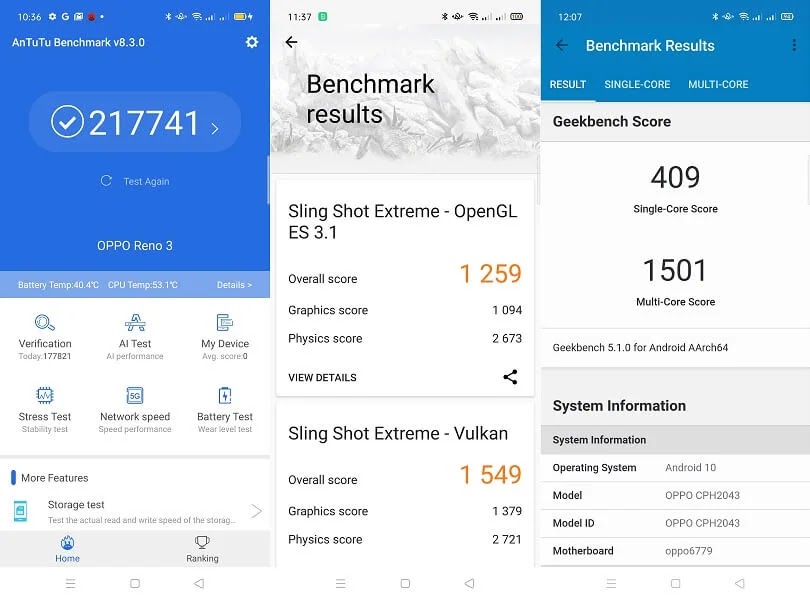
Benchmark Results
As you can see in the above table, the Helio P90 inside the Reno3 is much powerful when compared to the Snapdragon 665 chip found in the
However, the scores are noticeably lower except for PC Mark, please see below, when compared to the Qualcomm Snapdragon 730G found in the OPPO Reno2:
- AnTuTu – 263,603
- Geekbench (Single-Core) – 548
- Geekbench (Multi-Core) – 1,737
- PC Mark – 7,115
- 3D Mark Sling Shot – 3,438
- 3D Mark Sling Shot (Vulcan) – 2,267
- 3D Mark Sling Shot (OpenGL) – 2,397
With the results above, we firmly believed that the Reno3 is the successor of
We know a lot of people are quickly get disappointed when they learned that a phone uses a MediaTek processor, but we always tell them they are a reliable chip maker with quality products. And, the Helio P90 inside the Reno3 is a good testament to that.
Paired with 8GB of RAM and complemented by OPPO’s Game Space, the popular titles like Call of Duty Mobile, PUBG Mobile, Mobile Legends, NBA 2K20, and Asphalt 9 run smoothly even in high settings. Yes, it feels a bit warm when continuously playing for an hour or so, but it is nothing to be concerned about.
The audio quality is above average too, thanks to Dolby Atmos. Not only that, but audiophiles will also be happy as well as it supports Hi-Res audio. Moreover, consumers can also stream 1080p videos on Netflix, which makes the Reno3 an immersive multimedia phone.
As a daily driver for more than a week, we never had encountered hung ups or slow down, even with lots of apps open in the background. Both the in-display fingerprint sensor and face recognition can unlock the phone in almost an instant. However, we noticed that there are times that even when wearing a mask, face unlock still works.
Meanwhile, shutting down the phone takes about 3 seconds or less, while booting up usually takes less than 30 seconds.
Also Read:
CAMERA:
The camera department is one of the key selling points of the OPPO Reno3. Just like the Reno2 F, it has quad-camera set-up on its back, albeit, in a slightly different configuration. Both have similar, if not the same, 48MP f/1.8 main module, 8MP f/2.2 ultra-wide sensor, and 2MP mono lens. The difference is that the Reno3 dropped the 2MP depth sensor found in the Reno2 F, and opted for a 13MP telephoto lens for its 4th camera, which gives it the 2x optical and 5x hybrid zoom capability.

Quad Rear Cameras
As for the front camera, the Reno2 F and Reno3 have different value propositions. The former has only 16MP f/2.0 selfie snapper, but it offers a more sophisticated pop-up style. On the other hand, the latter has no stealth design, but it offers more pixels, a whopping 44MP sensor, one of the highest, if not the highest, resolution for a selfie camera.
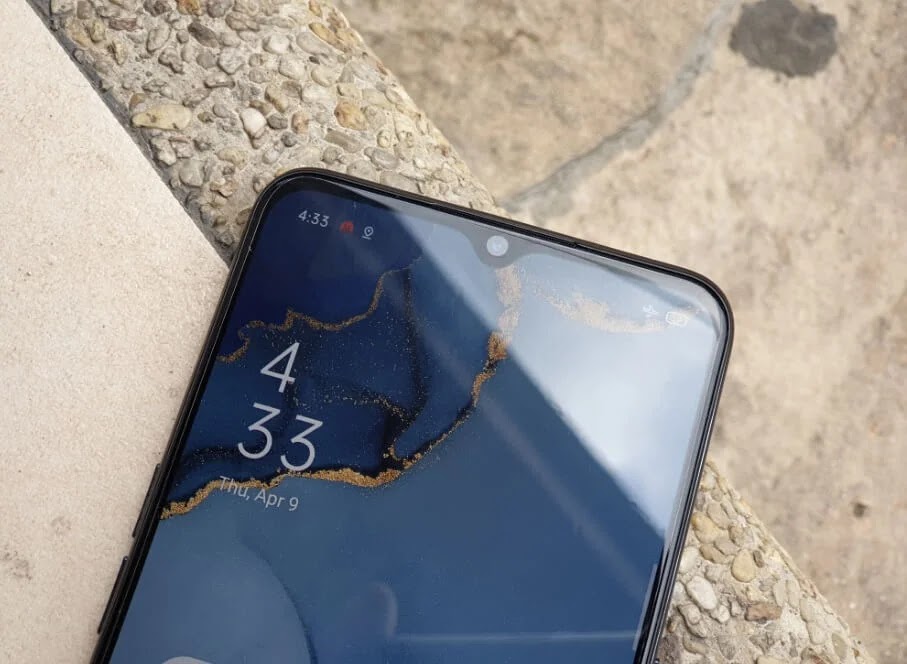
44MP Selfie Camera
The camera interface is quite similar to that of Realme UI, in fact, there are lots of similarities – from the layout to the icons, and even the Dazzle Color, which is the equivalent of Chroma Boost in Realme phones. But, don’t get us wrong, it also has unique features of its own, one of which is the XHD or Expert HD.

Camera Interface
The Expert HD can be found under the Expert Mode and gives “Ultra Clear” images with up to 108MP resolution!
Camera Samples:

Standard, 12MP

Standard, 48MP

Telescopic, 2x

Telescopic, 5x

Dazzle Color Off

Dazzle Color On

Macro

XHD, Telescopic
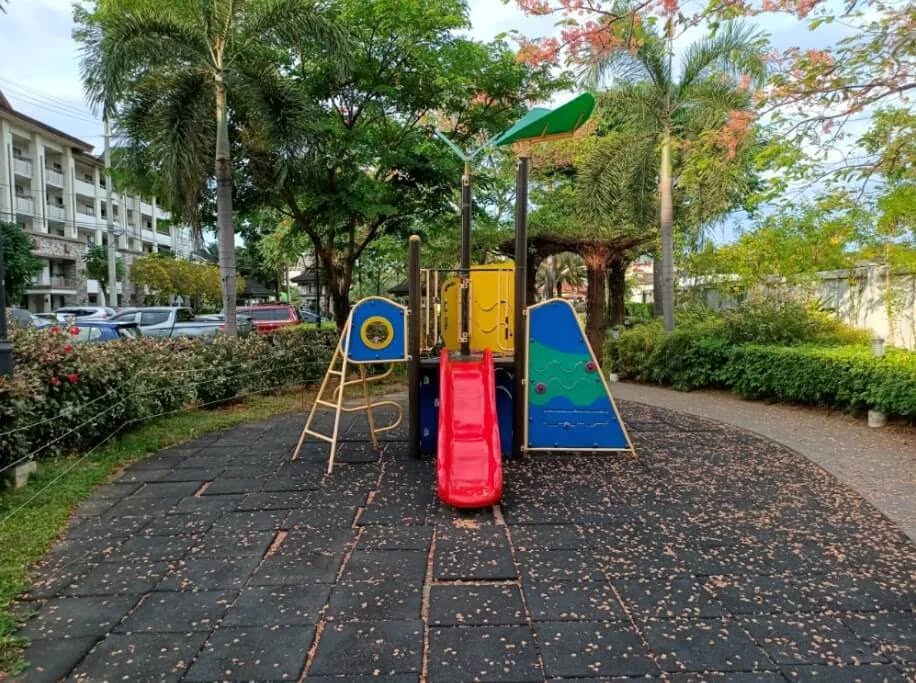
XHD, Standard
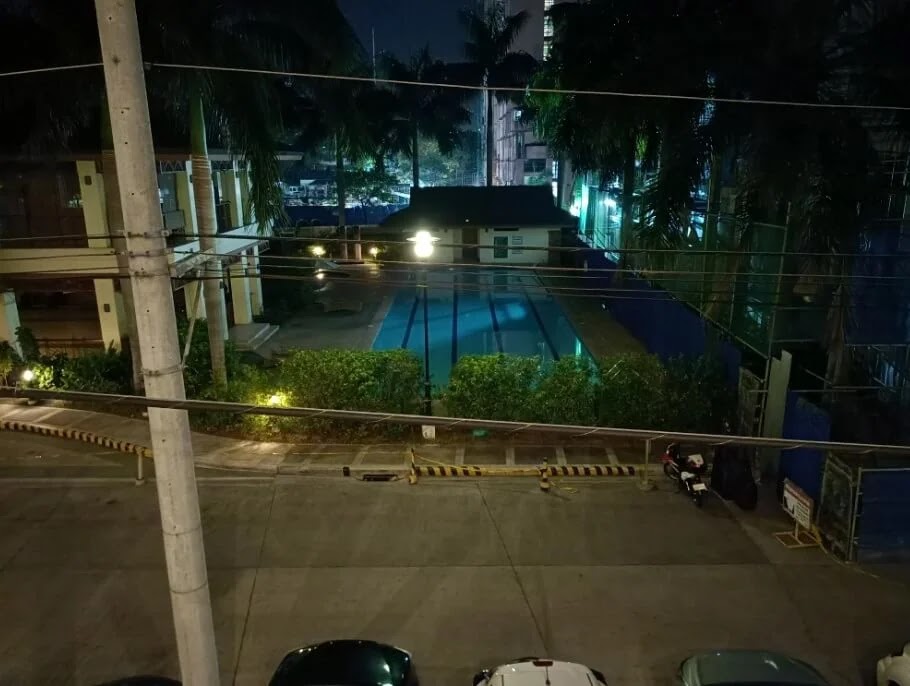
Night, Normal Mode
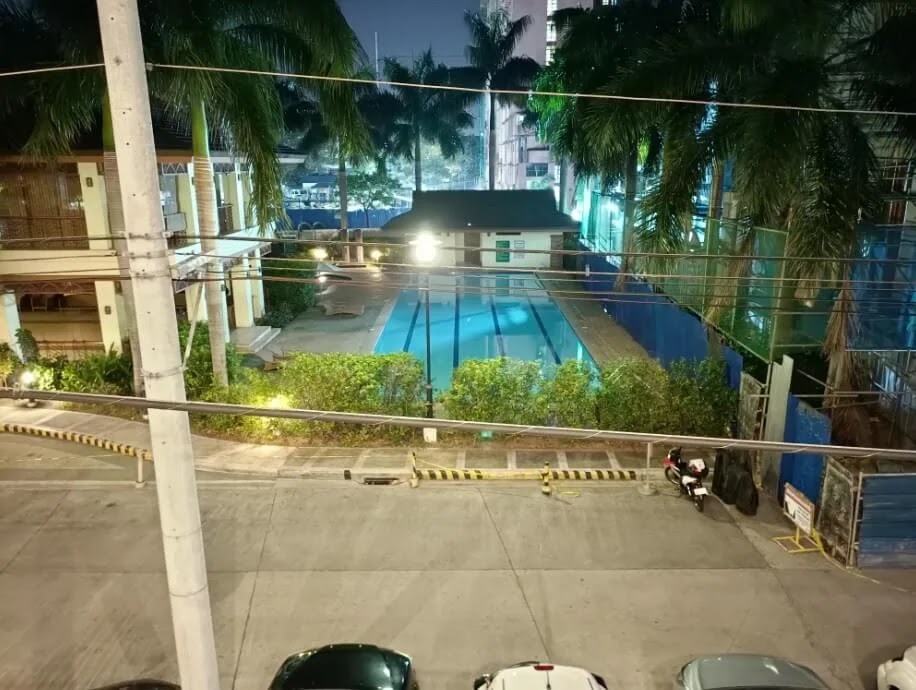
Night, Night Mode

Selfie

Portrait Selfie

Selfie with Face Mask
The quad rear cameras provide full focal length shooting, from normal to ultrawide, from 3cm macro to 20x zoom, and from 2MP to a whopping 108MP. The Reno3 is indeed a camera phone that offers lots of versatility. The output images are really sharp with full of accurate colors, the dynamic range is good too, especially when Dazzle color is turned on.
As for the 44MP f/2.4 front camera, we initially have doubts about it because the output produced when I was outdoor and wearing a mask is a bit darker than usual. But, when we used it indoor and without a face mask, the outputs are great. That’s why we performed a simple experiment, we tried wearing the mask again, and took some shots, the results went back to being dark. That said, we can simply say that the AI algorithm is not fine-tuned for people wearing face masks.
In terms of video capability, the rear cameras can record 4K at 30fps, 1080p and 720p up to 60fps, while the front camera can shoot up to 1080p at 30fps.
CONNECTIVITY:
The OPPO Reno3 launched in the Philippines is the 4G variant, which is also the one we have for review, unlike in China that has 5G connectivity. Nonetheless, the connection is fast and stable, whether it is indoor or outdoor. The WiFi connection is good too.
The other comms are reversible Bluetooth v5.0, USB Type-C, FM radio, and GPS.
BATTERY:
The Reno3 has 4,025mAh Lithium Polymer battery, which is just 25mAh higher than the Reno2 and Reno2 F. Since we reviewed it during the ECQ period, we used it almost non-stop, mostly for playing games, and we glad to report that it can last throughout the day. Speaking of mobile gaming, continuous playing for 30 minutes usually consumes about 10% battery charge on average.
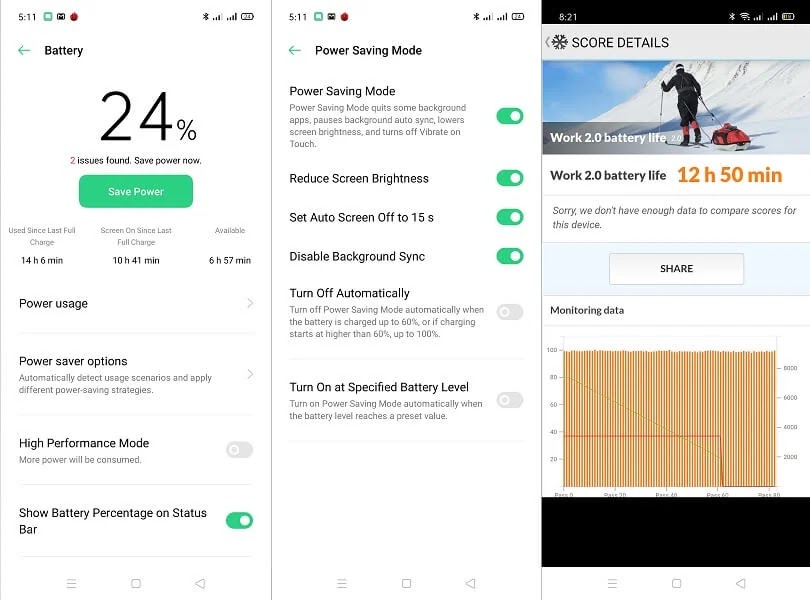
Camera Interface
As for the PC Mark Test, it scored more than 12 hours (12 hours and 50 minutes on the first test, and 12 hours 46 minutes on the second test), which can be considered above average. Comparing it with other phones that we reviewed with similar battery capacity, it is an hour higher than the Huawei Y9 Prime, but it is slightly lower than the A50s’ 14 hours.
OPPO advertised that the Reno3 recharges faster with its VOOC 3.0 technology – that’s 0% to 50% in just 30 minutes, and 0% to 100% in 73% minutes. In real life, we can safely say that the statement is pretty much accurate, and we applaud OPPO for it. During our test, it reaches 35% in just 20 minutes, 49% in half an hour, 63% in 40 minutes, 76% in 50 minutes, 89% in one hour, and 74 minutes to be fully charged from 0%.
FINAL WORDS:
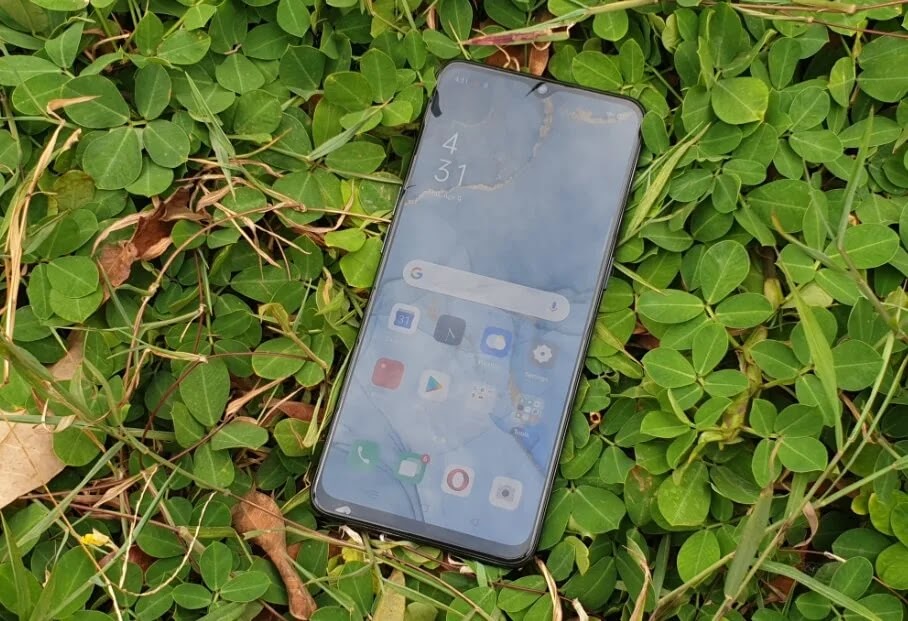
OPPO Reno3
The OPPO Reno3 is obviously a good all-rounder smartphone with a very decent overall performance. It can satisfy mobile gamers and photography enthusiasts as well as multimedia lovers.
Mục lục bài viết
OPPO Reno3 Specs (Philippines):
- Dual SIM, dual-standby, supports 4G LTE connectivity
- 6.4-inch AMOLED FHD+ (2400 x 1080) capacitive touchscreen
- Dimensions: 160.2mm x 73.3mm x 8mm
- Weight: 170 grams
- ColorOS 7 based on Android 10
- 2.2GHz 64-bit octa-core CPU, PowerVR GM9446 GPU, Helio P90 chipset
- 8GB of RAM
- 128GB internal storage, expandable up to 512GB via MicroSD card, uses dedicated slot
- 48MP f/1.8 PDAF + 13MP f/2.4 telephoto + 8MP f/2.2 ultra-wide + 2MP f/2.5 mono quad rear cameras; 2160 at 30fps, 1080p at 60fps video recording, gyro-EIS
- 44MP f/2.4 wide front camera, 1080p video recording at 30fps
- Multimedia Player
- 3.5mm audio jack
- WiFi 802.11 a/b/g/n/ac, dual-band,
- Bluetooth v5.0
- GPS with A-GPS, GLONASS, Galileo, BDS
- USB Type-C, supports OTG function
- Sensors: fingerprint (in-display), accelerometer, light, orientation, proximity, gyroscope, sound, magnetic
- Battery: 4,025mAh with 30W VOOC 4.0 flash charge
- Colors: Midnight Black, Sky White, Aurora Blue
- Price: Php18,990 (old); Php17,990 (new)
INTRODUCTION: Thecame quickly after its predecessor, the Reno2, that was released locally in October of 2019, which is barely six months. So, what changed from that short period? Let’s all find out in this review.PHYSICAL:Unlike the OPPO Reno2 series , the Reno3 veers away from the pop-up camera design. Instead, it goes back to the waterdrop notch screen we saw way back in 2018 in the likes of OPPO F9 and OPPO R17 Pro . The word waterdrop is just OPPO’s term for the display with a small notch at the upper center of the screen where the front camera is located.The 6.4-inch AMOLED panel mainly occupies the facade of the phone with a 90.8% screen-to-body ratio. It has Full HD+ resolution, that’s 2,400 x 1,080 pixels. There is no information about what kind of protective glass it has, but our review unit came with a pre-installed plastic film. So, that at least gives us peace of mind that it is protected against daily wear and tear.As expected, the AMOLED screen offers a bright display with good viewing angles and deep contrast. Meanwhile, the display settings have extensive items for users to tweak, such as the Low-Brightness Flicker-Free Eye Care to reduces visual fatigue, and Screen Color Temperature adjustment. Another thing is the system-wide Dark Mode, which is suitable for phones with AMOLED display.The Reno3 is thinner and lighter, it only measures 160.2mm x 73.3mm x 7.9mm and weighs only 170 grams, when compared to both the Reno2’s 160mm x 74.3mm x 9.5mm and 189 grams, and Reno2 F’s 161.8mm x 75.8mm x 8.7mm and 195 grams. Yes, we agree it is sleeker, however, on its back is the noticeable camera bump, something that you won’t find in the last year’s Reno family.Going at the back, it has OPPO’s “light-lapse” design with glass or glass-like finish. It comes in 3 color options, that one we have for review is called the Midnight Black, and the other two are Sky White and Aurora Blue.Moving through the sides, the top has the primary microphone, while the bottom holds the 3.5mm audio port, secondary microphone pinhole, USB Type-C port, and the loudspeaker grille. The right side has the power button, while the left has the volume keys and the triple card tray.By the way, the power button also doubles as the button for Google Assistant by default, but you can disable it under the system settings. When it is enabled, pressing and holding the button will first wake-up the digital assistant, while holding it for 3 seconds will prompt the power-off screen menu.You might notice in the above images that it has no visible fingerprint sensor, that is because it is placed underneath the display. It is an optical sensor, and it works quite fast. OPPO says that unlocking speed is 0.34s, and we can say it is true. Once you touched the display, it unlocks instantly, and the fireworks-like animation when unlocking looks cool too!OPPO just lent as only the unit itself, but according to their website, the retail package comes with free case, 30W VOOC charger, USB cable, earphones, SIM ejector tool, and paper documents.See Also: Smart Prepaid Offers OPPO Find X2 Pro for Only Php53,000 SOFTWARE:It runs on the latest OPPO software called ColorOS 7 , which is based on Android and was launched in India around December of 2019. We already received several updates from the time we reviewed the phone, and the latest was earlier this April (CPH2043_11_A.13). We love timely updates. However, we noticed that even the security patch update only requires too much data. Just like, for example, the March CPH2043_11_A.09 update, wherein 3GB data is needed.By the way, it has 128GB of internal storage, wherein 16.2GB is used upon the first boot up – 15.7GB for the system and 469MB for the pre-installed apps.Moving on, the new custom Android-based operating system of OPPO has the tagline Smooth and Delightful. It has upgraded aesthetic features, such as livelier style and more comfortable visual effects.It is also equipped with AI that accurately identifies usage scenarios through big data analysis. OPPO calls them oFas, a mechanism of cache preload that makes cold starts as fast as warm starts; oMem that adapts to user habits by shifting and allocating system resources accordingly and efficiently; and oSense, a scheduling mechanism that gives priority to front-end and user-related threads.Moreover, it comes with lots of cool items; some of them are as follows:Of course, popular features of the previous ColorOS version are still there, such as the Clone Phone, Smart Sidebar, Smart Assistant, and App Lock. Users can also easily access Screen Recording, OPPO Share, and Dark Mode through the quick settings menu.To learn more about ColorOS, you can visit https://www.coloros.com/en/coloros7 PERFORMANCE:The Reno3 is the first device that we reviewed that is powered by MediaTek Helio P90 chipset . This chip was introduced in the latter part of December 2018. It is packed with up to 2.2GHz octa-core CPU, PowerVR GM9446 GPU, and APU 2.0 AI architecture, which as MediaTek advertised, is 4x more powerful than its predecessor, the Helio P70.As always, we run it through our favorite benchmarking tools, and the scores are as follows.As you can see in the above table, the Helio P90 inside the Reno3 is much powerful when compared to the Snapdragon 665 chip found in the OPPO A9 2020 and even with the newer Helio G70 gaming chip inside the Realme C3 . Note that we do not have the score for the Geekbench 5 Renderscript as it always closes down for unknown reasons while we are running it.However, the scores are noticeably lower except for PC Mark, please see below, when compared to the Qualcomm Snapdragon 730G found in the OPPO Reno2:With the results above, we firmly believed that the Reno3 is the successor of Reno2 F , especially that the latter is powered by Helio P70, while the Reno3 Pro is the true successor of the Reno2 We know a lot of people are quickly get disappointed when they learned that a phone uses a MediaTek processor, but we always tell them they are a reliable chip maker with quality products. And, the Helio P90 inside the Reno3 is a good testament to that.Paired with 8GB of RAM and complemented by OPPO’s Game Space, the popular titles like Call of Duty Mobile, PUBG Mobile, Mobile Legends, NBA 2K20, and Asphalt 9 run smoothly even in high settings. Yes, it feels a bit warm when continuously playing for an hour or so, but it is nothing to be concerned about.The audio quality is above average too, thanks to Dolby Atmos. Not only that, but audiophiles will also be happy as well as it supports Hi-Res audio. Moreover, consumers can also stream 1080p videos on Netflix, which makes the Reno3 an immersive multimedia phone.As a daily driver for more than a week, we never had encountered hung ups or slow down, even with lots of apps open in the background. Both the in-display fingerprint sensor and face recognition can unlock the phone in almost an instant. However, we noticed that there are times that even when wearing a mask, face unlock still works.Meanwhile, shutting down the phone takes about 3 seconds or less, while booting up usually takes less than 30 seconds.Also Read: OPPO A31 with Triple Rear Camera, 4GB RAM, 128GB ROM is Priced at Php8,990 CAMERA:The camera department is one of the key selling points of the. Just like the Reno2 F, it has quad-camera set-up on its back, albeit, in a slightly different configuration. Both have similar, if not the same, 48MP f/1.8 main module, 8MP f/2.2 ultra-wide sensor, and 2MP mono lens. The difference is that the Reno3 dropped the 2MP depth sensor found in the Reno2 F, and opted for a 13MP telephoto lens for its 4th camera, which gives it the 2x optical and 5x hybrid zoom capability.As for the front camera, the Reno2 F and Reno3 have different value propositions. The former has only 16MP f/2.0 selfie snapper, but it offers a more sophisticated pop-up style. On the other hand, the latter has no stealth design, but it offers more pixels, a whopping 44MP sensor, one of the highest, if not the highest, resolution for a selfie camera.The camera interface is quite similar to that of Realme UI, in fact, there are lots of similarities – from the layout to the icons, and even the Dazzle Color, which is the equivalent of Chroma Boost in Realme phones. But, don’t get us wrong, it also has unique features of its own, one of which is the XHD or Expert HD.The Expert HD can be found under the Expert Mode and gives “Ultra Clear” images with up to 108MP resolution!The quad rear cameras provide full focal length shooting, from normal to ultrawide, from 3cm macro to 20x zoom, and from 2MP to a whopping 108MP. The Reno3 is indeed a camera phone that offers lots of versatility. The output images are really sharp with full of accurate colors, the dynamic range is good too, especially when Dazzle color is turned on.As for the 44MP f/2.4 front camera, we initially have doubts about it because the output produced when I was outdoor and wearing a mask is a bit darker than usual. But, when we used it indoor and without a face mask, the outputs are great. That’s why we performed a simple experiment, we tried wearing the mask again, and took some shots, the results went back to being dark. That said, we can simply say that the AI algorithm is not fine-tuned for people wearing face masks.In terms of video capability, the rear cameras can record 4K at 30fps, 1080p and 720p up to 60fps, while the front camera can shoot up to 1080p at 30fps.CONNECTIVITY:Thelaunched in the Philippines is the 4G variant, which is also the one we have for review, unlike in China that has 5G connectivity. Nonetheless, the connection is fast and stable, whether it is indoor or outdoor. The WiFi connection is good too.The other comms are reversible Bluetooth v5.0, USB Type-C, FM radio, and GPS.BATTERY:The Reno3 has 4,025mAh Lithium Polymer battery, which is just 25mAh higher than the Reno2 and Reno2 F. Since we reviewed it during the ECQ period, we used it almost non-stop, mostly for playing games, and we glad to report that it can last throughout the day. Speaking of mobile gaming, continuous playing for 30 minutes usually consumes about 10% battery charge on average.As for the PC Mark Test, it scored more than 12 hours (12 hours and 50 minutes on the first test, and 12 hours 46 minutes on the second test), which can be considered above average. Comparing it with other phones that we reviewed with similar battery capacity, it is an hour higher than the Huawei Y9 Prime, but it is slightly lower than the A50s’ 14 hours.OPPO advertised that the Reno3 recharges faster with its VOOC 3.0 technology – that’s 0% to 50% in just 30 minutes, and 0% to 100% in 73% minutes. In real life, we can safely say that the statement is pretty much accurate, and we applaud OPPO for it. During our test, it reaches 35% in just 20 minutes, 49% in half an hour, 63% in 40 minutes, 76% in 50 minutes, 89% in one hour, and 74 minutes to be fully charged from 0%.FINAL WORDS:Theis obviously a good all-rounder smartphone with a very decent overall performance. It can satisfy mobile gamers and photography enthusiasts as well as multimedia lovers.











